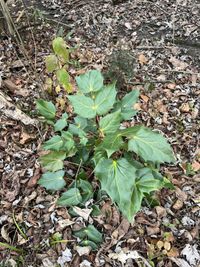Beale's Barberry Mahonia bealei
Nobody is growing this yet. You could be the first!
Shrubs , evergreen, 1-2 m. Stems monomorphic, without short axillary shoots. Bark of 2d-year stems tan, glabrous. Bud scales 11-13 mm, persistent. Spines absent. Leaves 5-9-foliolate; petioles 2-8 cm. Leaflet blades thick and rigid; surfaces abaxially smooth, shiny, adaxially dull, gray-green; terminal leaflet stalked, blade 6.5-9.3 × 4-7 cm, 1.3-2.3 times as long as wide; lateral leaflet blades ovate or lance-ovate, 4-6-veined from base, base truncate or weakly cordate, margins plane, toothed, with 2-7 teeth 3-8 mm tipped with spines to 1.4-4 × 0.3-0.6 mm, apex acuminate. Inflorescences racemose, dense, 70-150-flowered, 5-17 cm; bracteoles ± corky, apex rounded to acute. Berries dark blue, glaucous, oblong-ovoid, 9-12 mm, juicy, solid.
Flowering fall-winter (Dec-Mar). Open woodlands and shrublands; 100-500 m; introduced; Ala., Ga., N.C., Va.; native, Asia (China).
Berberis bealei is commonly cultivated; although it rarely escapes, it is locally naturalized in the southeastern United States. It is resistant to infection by Puccinia graminis .

Predictions
Perennial
living more than two yearsPhotos
Beale's barberry crops
Crop Map
Only plantings by members who have set their locations are shown on this map.
What people are saying about Beale's barberries
Nobody has posted about Beale's barberries yet.
Sign in or sign up to post your tips and experiences growing Beale's barberries.
History
How to grow Beale's barberries
Alternate names
See who's planted Beale's barberries
Beale's barberry harvests
Nobody has harvested this crop yet.
Find Beale's barberry seeds
There are no seeds available to trade on Growstuff right now.
- Purchase seeds via Ebay
- Sign in or sign up to list your seeds to trade.

